Items
Tag
sculpture
-
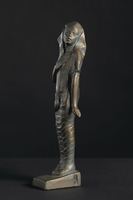 Ethiopia Painted plaster sculpture of a female figure standing with her right hand over her heart, her left arm straight against her side with her hand extended out. Her head is turned over her left shoulder. From the hips down her legs are bound as if mummified. She wears a veil that is draped over her head and falls over her shoulders and down her back. The veil is shaped to resemble a pharaonic headdress. The figure stands on a rectangular, slightly wedge shaped pedestal. The sculpture is painted to look like copper complete with a simulated greenish patina. (Smithsonian Collections Search Center)
Ethiopia Painted plaster sculpture of a female figure standing with her right hand over her heart, her left arm straight against her side with her hand extended out. Her head is turned over her left shoulder. From the hips down her legs are bound as if mummified. She wears a veil that is draped over her head and falls over her shoulders and down her back. The veil is shaped to resemble a pharaonic headdress. The figure stands on a rectangular, slightly wedge shaped pedestal. The sculpture is painted to look like copper complete with a simulated greenish patina. (Smithsonian Collections Search Center) -
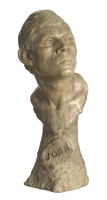 John the Baptist A painted plaster sculpture bust of John the Baptist. The head is turned slightly to the left, with closely cropped hair. The face is alert, with raised chin and open eyes. There is a tall integrated mount and base extending from the bust. It features an oval roundel inscribed with the name "John." The sculpture is painted a light beige. (Smithsonian Collections Search Center)
John the Baptist A painted plaster sculpture bust of John the Baptist. The head is turned slightly to the left, with closely cropped hair. The face is alert, with raised chin and open eyes. There is a tall integrated mount and base extending from the bust. It features an oval roundel inscribed with the name "John." The sculpture is painted a light beige. (Smithsonian Collections Search Center) -
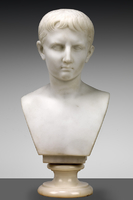 Young Octavian Young Octavian, or Augustus, shows the adopted heir of Julius Caesar. It is a copy of a sculpture in the Vatican galleries that dates from the late eighteenth or early nineteenth century. Many artists copied this piece, and it became so popular that tourists could even order reproductions from a catalogue. Edmonia Lewis’s version was considered to be one of the best available, as described by a descendant of one of her patrons: “[It] seemed to all of us the best reproduction of the original then offered by any artist in Rome.” (Smithsonian Collections Search Center)
Young Octavian Young Octavian, or Augustus, shows the adopted heir of Julius Caesar. It is a copy of a sculpture in the Vatican galleries that dates from the late eighteenth or early nineteenth century. Many artists copied this piece, and it became so popular that tourists could even order reproductions from a catalogue. Edmonia Lewis’s version was considered to be one of the best available, as described by a descendant of one of her patrons: “[It] seemed to all of us the best reproduction of the original then offered by any artist in Rome.” (Smithsonian Collections Search Center) -
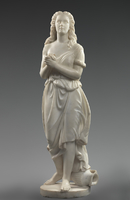 Hagar
Hagar
-
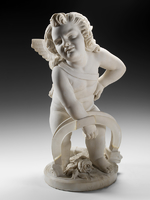 Poor Cupid Edmonia Lewis occasionally carved sculptures of mythical scenes, which were very popular with American tourists visiting Rome. Poor Cupid, or Love Ensnared, depicts the cherub with his hand caught in a trap as he reaches down for a rose. Frivolous sculptures like this appealed to the Victorian sentimentality of affluent Americans traveling around Europe. (Smithsonian Collections Search Center)
Poor Cupid Edmonia Lewis occasionally carved sculptures of mythical scenes, which were very popular with American tourists visiting Rome. Poor Cupid, or Love Ensnared, depicts the cherub with his hand caught in a trap as he reaches down for a rose. Frivolous sculptures like this appealed to the Victorian sentimentality of affluent Americans traveling around Europe. (Smithsonian Collections Search Center) -
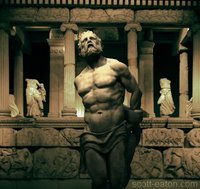 Prometheus and Digital Sculpture “The piece is my [Eaton’s] own interpretation of the Prometheus myth, and is not based on any existing sculptures.”
Prometheus and Digital Sculpture “The piece is my [Eaton’s] own interpretation of the Prometheus myth, and is not based on any existing sculptures.” -
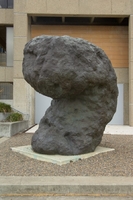 Prometheus (for Franz Kafka) “Tucker was a leading member of the New Generation of sculptors in London in the mid sixties. Their influence on Australian steel sculpture has continued to the present. Tucker however has moved on to other media and very different forms. This vast sculpture was made in plaster and cast directly in bronze. It suggests animated form being drawn up out of the earth. The cloud like volume may be seen as humanoid or as primal matter. Unlike other contemporary artists making large scale bronzes the original was modelled full size by the artist and not enlarged by technological processes. The surface is therefore a direct impression of the making process and the artist's gestures.”
Prometheus (for Franz Kafka) “Tucker was a leading member of the New Generation of sculptors in London in the mid sixties. Their influence on Australian steel sculpture has continued to the present. Tucker however has moved on to other media and very different forms. This vast sculpture was made in plaster and cast directly in bronze. It suggests animated form being drawn up out of the earth. The cloud like volume may be seen as humanoid or as primal matter. Unlike other contemporary artists making large scale bronzes the original was modelled full size by the artist and not enlarged by technological processes. The surface is therefore a direct impression of the making process and the artist's gestures.” -
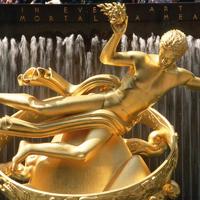 Prometheus “Prometheus is said to be the best-known sculpture in Rockefeller Center and the most photographed monumental sculpture in all of NYC. Created by famed American sculptor Paul Manship, who held a great fascination for mythological subjects and events, it has become the main attraction of the Lower Plaza. Its central theme is best stated by the quote that’s carved in the red granite wall behind him, taken from the sixth-century B.C. Greek dramatist Aeschylus: ‘Prometheus, Teacher in Every Art, Brought the Fire That Hath Proved to Mortals a Means to Mighty Ends.’”
Prometheus “Prometheus is said to be the best-known sculpture in Rockefeller Center and the most photographed monumental sculpture in all of NYC. Created by famed American sculptor Paul Manship, who held a great fascination for mythological subjects and events, it has become the main attraction of the Lower Plaza. Its central theme is best stated by the quote that’s carved in the red granite wall behind him, taken from the sixth-century B.C. Greek dramatist Aeschylus: ‘Prometheus, Teacher in Every Art, Brought the Fire That Hath Proved to Mortals a Means to Mighty Ends.’” -
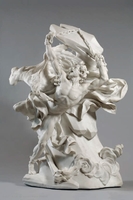 Prometheus, Chained to Mount Caucus, has his Liver Devoured by an Eagle “The Titan Prometheus, protector of men, stole fire from Mount Olympus. Furious, Zeus inflicted a terrible and cruel punishment on him. He chained him to the summit of Mount Caucasus, where an eagle came daily to peck at his liver, which constantly replenished itself. Prometheus, straining his every muscle, screams in agony. The instrument of his crime, the torch, lies at his feet.”
Prometheus, Chained to Mount Caucus, has his Liver Devoured by an Eagle “The Titan Prometheus, protector of men, stole fire from Mount Olympus. Furious, Zeus inflicted a terrible and cruel punishment on him. He chained him to the summit of Mount Caucasus, where an eagle came daily to peck at his liver, which constantly replenished itself. Prometheus, straining his every muscle, screams in agony. The instrument of his crime, the torch, lies at his feet.” -
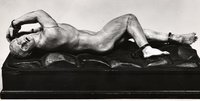 Untitled statuette “Statuette; ivory; carved; a nude figure in the form of Prometheus, who is shackled and chained at his wrists and ankle to a rock; the chains and rock are made of bronze, attached to a rectangular base by means of a screw with a washer in the form of a coin.”
Untitled statuette “Statuette; ivory; carved; a nude figure in the form of Prometheus, who is shackled and chained at his wrists and ankle to a rock; the chains and rock are made of bronze, attached to a rectangular base by means of a screw with a washer in the form of a coin.” -
 The creation of man by Prometeus “Prometeus, seated, is intent on observing his creature; the man, still a motionless clay puppet, stiffly lying at his feet, is surrounded by the greatest deities of the Greek pantheon. In a pre-eminent position there are Hera and Zeus in the act of giving Hermes the money with which to redeem the life of man from the Hades. Next to Hermes there is Poseidon with his trident; in the two upper corners, the chariot of Selene and the chariot of Apollo between Zeus and the man; finally, the Erotes induce Psyche, the soul, to give birth to the first human being.”
The creation of man by Prometeus “Prometeus, seated, is intent on observing his creature; the man, still a motionless clay puppet, stiffly lying at his feet, is surrounded by the greatest deities of the Greek pantheon. In a pre-eminent position there are Hera and Zeus in the act of giving Hermes the money with which to redeem the life of man from the Hades. Next to Hermes there is Poseidon with his trident; in the two upper corners, the chariot of Selene and the chariot of Apollo between Zeus and the man; finally, the Erotes induce Psyche, the soul, to give birth to the first human being.” -
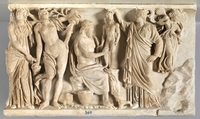 Prometheus models the first man “This fragment of a Roman sarcophagus depicts the Titan, Prometheus, modelling a statue of a nude youth. Minerva touches its head with a butterfly (psyche in Greek, meaning soul), bringing it to life. The action takes place in a natural setting, with a naked river nymph and a clothed tree nymph.”
Prometheus models the first man “This fragment of a Roman sarcophagus depicts the Titan, Prometheus, modelling a statue of a nude youth. Minerva touches its head with a butterfly (psyche in Greek, meaning soul), bringing it to life. The action takes place in a natural setting, with a naked river nymph and a clothed tree nymph.” -
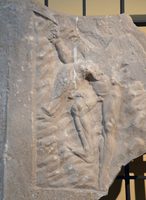 Untitled relief “Relief decorating the seating area entrances of the Roman Amphitheatre of Capua (Italy). It depicts Prometheus having his liver eaten by an eagle. Age of Hadrian (117-138 CE). (Capua Gladiator Museum)”
Untitled relief “Relief decorating the seating area entrances of the Roman Amphitheatre of Capua (Italy). It depicts Prometheus having his liver eaten by an eagle. Age of Hadrian (117-138 CE). (Capua Gladiator Museum)”